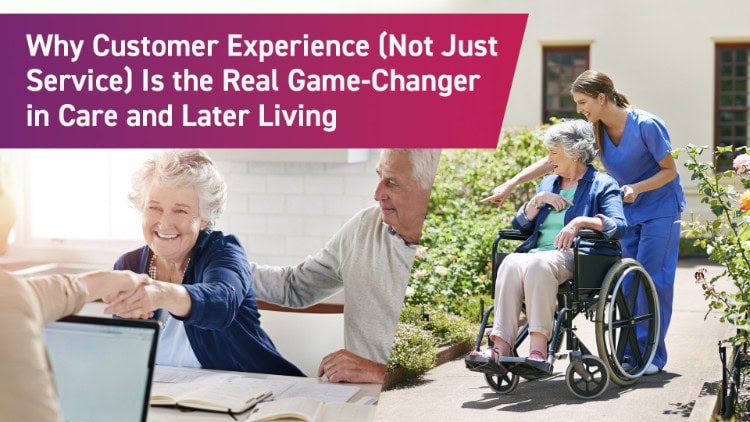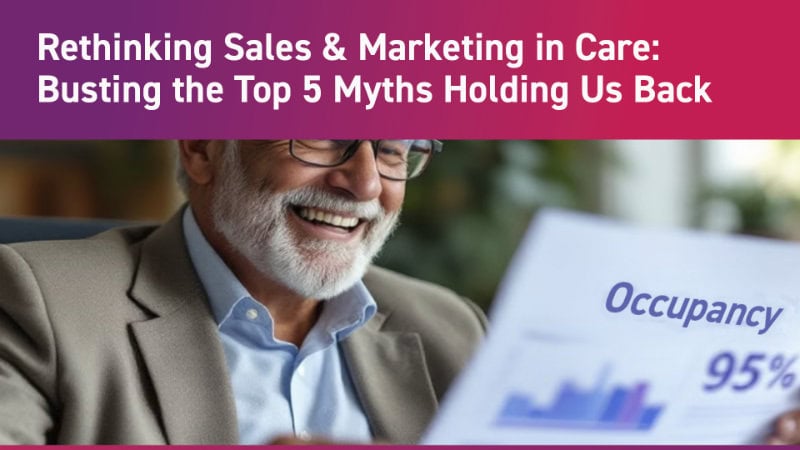Choosing a care home or later living community isn’t just a financial decision – it’s emotional, and always deeply personal.
Whether it’s a family seeking support for Mum’s next chapter or a couple planning their future, what matters most is how your service feels.
That’s why now, more than ever, it’s time to stop treating Customer Experience (CX) and Customer Service (CS) as the same thing.
According to research from Gartner, 89% of companies compete primarily on customer experience. The care and later living sectors are no exception.
And while good service might get you through a tour, it’s the overall experience that earns trust, secures move-ins, and builds long-term reputation.
What’s the Real Difference Between Customer Service (CS) and Customer Experience (CX)?
Many providers still use the terms interchangeably. But the distinction matters:
Customer service is reactive. It steps in when someone asks a question, raises a concern, or requests help.
Customer experience is proactive. It’s about shaping every step of the journey, from the moment someone clicks on your website to how they feel days or even weeks after touring your community.
In practice:
CS is about how quickly a call is answered.
CX is about whether that call leaves someone feeling reassured, seen, and supported CS is a task. CX is a strategy.
And in this sector, where people are making one of the biggest decisions of their lives, that strategy needs to be human, thoughtful, and deeply consistent.
Why You Should Benchmark Beyond the Later Living and Care Home Sector
One common pitfall? You’re probably only comparing your customer experience to other care homes or later living communities.
However, the people enquiring about your services are also staying in hotels, shopping online, and managing everyday tasks through seamless, intuitive digital experiences. Whether consciously or not, they’re bringing those expectations with them.
If your website feels clunky, your tone feels clinical, or your process is harder than booking a weekend away, you may lose them before you even know they were interested.
The best operators don’t just ask, “How do we compare to other providers?”
They ask, “How does this feel compared to the best service I’ve received, anywhere?”
That’s where the real opportunity lies.
The Power of Micro-Moments
Potential residents and families aren’t just weighing up price or postcode. They’re asking:
- Am I ready for this move?
- Is this the right lifestyle for me?
- Will Mum be treated with kindness?
- Do I trust these people to keep me safe?
- Will I still feel like me if I move here?
These questions aren’t answered in brochures. They’re answered in those tiny, emotional cues people instinctively pick up on – the smile on arrival, the follow-up call that remembers a personal detail, the quiet confidence in a team member’s voice.
These are the elemental moments that form the foundation of great CX.
Why Outcome Metrics Aren’t Enough
Many providers still measure success using outcome metrics like:
- Net Promoter Scores
- Online reviews
- Satisfaction surveys
Useful? Yes – but limited.
These metrics tell you what the result was, but not why. They don’t explain why a family didn’t book a second tour, or why someone left a glowing review but still chose a competitor.
To build better customer experiences, you need to zoom in on the elemental metrics – the tangible, observable behaviours that shape a person’s perception.
For example:
- Was the visitor greeted by name?
- Was the tour tailored to their circumstances?
- Was the team confident, kind, and consistent?
- Did the environment feel clean, calm, and welcoming?
These are things you can measure. And more importantly, improve.
Real CX Strategy Looks Like This
We’ve supported later living providers and care homes who are rethinking the way they approach their customer journey. Here’s what sets them apart:
1. They map the whole experience
Not just the tour. From web visits to enquiry calls to follow-up emails, they view the journey as a series of interconnected emotional moments, not isolated tasks.
2. They train for connection
It’s not enough to know the facts. The best teams are trained in tone, empathy, listening, and timing. They know how to build trust from the very first interaction.
3. They blend emotional insight with data
Yes, NPS and review scores matter. But they’re paired with mystery shopping, team reflections, and experience checklists that track how people feel, not just what they say.
4. They understand that everyone plays a role
Customer experience isn’t “the receptionist’s job” or “the sales manager’s job.” It’s everyone – from kitchen staff to night carers. Every person can shape perception.
What’s at Stake?
This isn’t about vanity metrics or fluffy language. It’s about occupancy. Reputation. Retention.
The providers getting this right are the ones:
- Growing sustainably through word of mouth
- Attracting the right-fit residents and families
- Retaining staff who feel proud of the environment they’re part of
And those who aren’t? They’re often left wondering why interest is high… but conversions stay stubbornly low.
More often than not, it’s this: the experience didn’t quite land.
Final Thought
In care and later living, you don’t just offer services – you offer trust.
And trust isn’t built on brochures or price lists. It’s built in the everyday moments: the eye contact, the warmth, the quiet confidence in your team’s voice.
Get those right, and you’ll create a customer experience that not only earns loyalty but becomes your most powerful sales and retention tool.
Ready to move from good service to a great experience?
At Commercial Acceleration, we help care homes, later living communities, and hotels turn everyday moments into memorable, measurable experiences.
Let’s talk about how your customer experience strategy could boost occupancy, build trust, and strengthen your brand.


